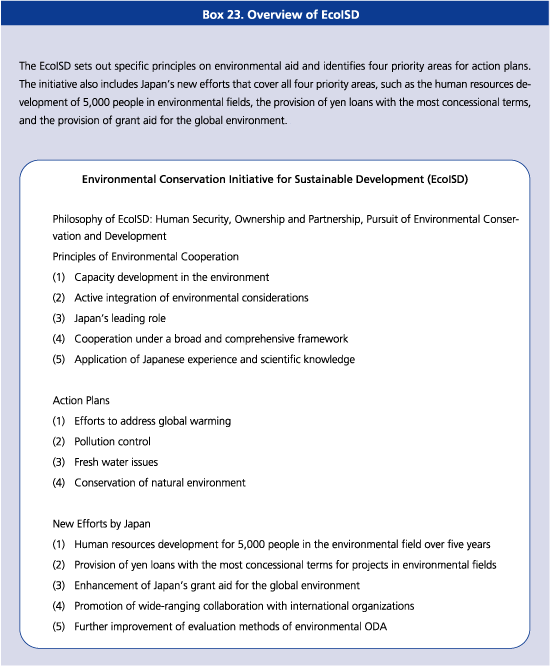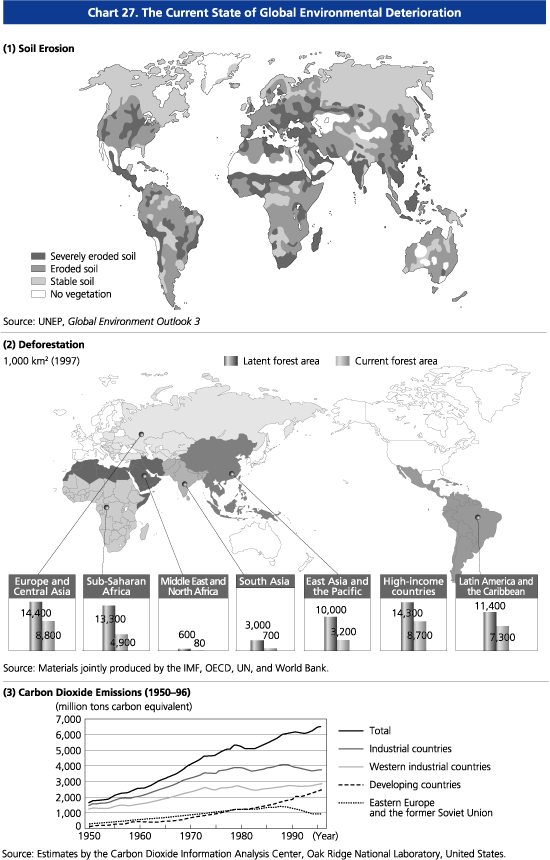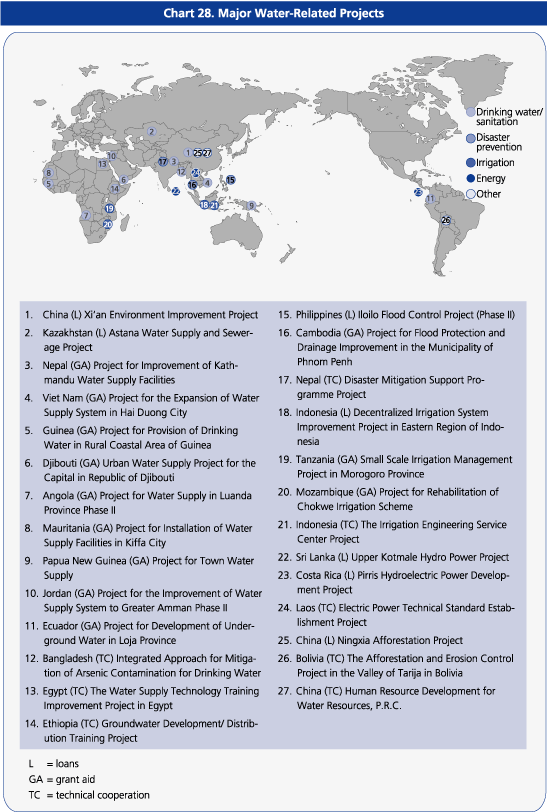Official Development Assistance (ODA)
Japan's ODA White Paper 2002
Part I. Trends in Japan's ODA in a Rapidly Changing World
Chapter 2, Section 5
(3) Environmental Cooperation for Sustainable Development
World Trends Relating to Sustainable Development While environmental problems have been discussed worldwide since the 1970s, it was the UN Conference on Environment and Development (UNCED), or Earth Summit, in 1992 that brought this issue to the forefront of international debate. After comprehensive deliberations on environmental problems, Agenda 21 was adopted as a shared plan of action for all countries of the world. In Agenda 21, sustainable development.14 was used as the key concept relevant to the whole debate, and became a keyword for following efforts in response to global environmental problems.
Ten years after UNCED, the World Summit on Sustainable Development (WSSD) was held in Johannesburg in September 2002. During this decade, "sustainable development" has become established as a concept of development consisting of economic, social, and environmental elements. For this reason, discussions at the Johannesburg Summit focused not only on environmental issues but also on broader economic and social aspects of development. Therefore, the Johannesburg Declaration on Sustainable Development and the Plan of Implementation adopted at the WSSD are based on the view that the global trend of environmental deterioration has not been reversed since UNCED, that the issue of poverty must be overcome to prevent environmental degradation in developing countries, and that concrete action is needed to achieve the MDGs, including environmental conservation.
Announcement of EcoISD In August 2002, prior to the Johannesburg Summit, Japan announced the Koizumi Initiative of concrete measures for sustainable development, which contained, in response to growing international concern about the global environment, the Environmental Conservation Initiative for Sustainable Development (EcoISD), which defines Japan's philosophy and policies on environmental cooperation and outlines an action plan as a pillar for future cooperation. The EcoISD expresses that, while respecting the ownership of developing countries, cooperation should place emphasis on support for capacity building. It identifies efforts to address global warming, pollution control, fresh water issues, and conservation of the natural environment as priority areas for Japan's environmental ODA. As a concrete goal, it states that Japan will provide support for human resources development for 5,000 people in the environmental field over a five-year period from fiscal year 2002.
Following this policy, Japan's environmental ODA will support developing countries in a broad range of areas, as cited below, to overcome pollution accompanying economic development; to resolve the problem of poverty which lies at the root of environmental problems; and to respond to global environmental issues.
A. Efforts to Address Global Warning Japan will work to transfer and spread technologies related to countermeasures against global warming to developing countries and to help enhance the capacity to address this issue from scientific, social, and systematic perspectives. For example, Japan has provided assistance for the establishment of an energy conservation training center in Iran and the Upper Kotmale Hydropower Project in Sri Lanka, and it has been carrying out a variety of basic studies, primarily in Asia.
B. Pollution Control Japan will provide prioritized assistance to control pollution and improve the living environment in urban areas?such as controls on air and water pollution and waste management, mainly in the Asian region where economies are rapidly growing. For example, Japan has provided assistance to strengthen the capacity of developing countries through environment centers at the core of environmental administration in six countries, such as China and Mexico. It will also provide assistance in equipment for improved waste management in Hanoi, Viet Nam.
C. Fresh Water Issues Japan will implement water and sewerage programs that take the varying characteristics of urban and rural areas into account and promote "soft" cooperation for water resource management and protection of water quality control. Support measures include improving water quality in outlying cities in the Philippines, assisting community activities to secure safe drinking water in Senegal, and utilizing grant aid for grassroots projects to help NGOs and other organizations provide water supply in Pakistan, Tanzania, and elsewhere.
D. Conservation of the Natural Environment Japan will assist developing countries in conserving nature reserves and forests, preventing desertification, and managing natural resources, while giving consideration to efforts for poverty reduction. Examples include support to Biodiversity Conservation Project Phase II in Indonesia, an ecosystem protection project in the Galapagos Islands in Ecuador, the Forest Conservation and Afforestation Project Phase II in Laos, and the promotion of the Asia Forest Partnership (AFP).15
Japan is actively promoting environmental cooperation with China. China's rapid economic development has been accompanied by severe environmental damage, including dust storms, which have deposited so-called yellow sand even on Japan. Thus Japan recognized environmental problems as one of the priority areas to tackle in the Economic Cooperation Program for China formulated and announced in 2001. In fact, over half of Japan's yen loans to China in fiscal year 2001 were devoted to a wide array of environment-related projects.
Japan-China Environmental Cooperation Week was held in Beijing in October 2002 to commemorate the thirtieth anniversary of the normalization of Japan-China relations. Participants from both the public and private sectors involved in environmental cooperation in both countries gathered for a packed week of events relating to environmental cooperation between Japan and China, including the Fourth Japan-China Comprehensive Forum on Environmental Cooperation.
In recent years, a concerted effort has been made to coordinate financial support and technical cooperation in the implementation of environmental projects. For instance, under the Japan-China Environmental Development Model Cities Plan, Japan has provided yen loans for projects designed to combat air pollution based on the recommendations of a committee of experts. It has also dispatched experts in an effort to improve the environmental management capacities of the designated model cities. Now, these actions are contributing to the improvement of the environments of the three model cities of Dalian, Guiyang, and Chongqing.
Japan is also engaged in afforestation projects in China as part of its environmental cooperation efforts. Japan is utilizing both yen loans and grant aid to effect afforestation in the central Huang He (Yellow River) Basin, particularly on the Loess Plateau, whose desertification is considered one source of the incidents of yellow sand storms. In addition, technical cooperation is being provided to assist research on plants suitable for arid land. These efforts are expected to help vegetation recover in areas where desertification has occurred and to help control the dispersal of yellow sand.
1. Environmental Conservation within the Japanese ODA Framework (as of December 2002)
ODA Charter (accepted by the Cabinet in June 1992)
- "Basic Philosophy" positions environmental conservation as a "task for all humankind."
- "Principles" mandate that environmental conservation and development be pursued "in tandem."
- "Priority Issues" list the environment among "global problems."
Medium-Term Policy (formulated in August 1999)
- Lists "environmental conservation" among "Priority Issues and Sectors."
- Explicitly includes "environmental considerations" among "points to be followed in the implementation and management of ODA."
Environmental Conservation Initiative for Sustainable Development (EcoISD) (announced in August 2002)
- Sets out the Philosophy, Principles, and Action Plans of Environmental ODA.
Kyoto Initiative (announced in December 1997)
- Specific actions for climate change programs (specific actions for ISD).
Country Assistance Program
- Formulated for major aid recipients in order to enhance country-by-country approach.
2. Evolution of Environmental ODA Initiatives
- July 1989: Arch Summit (Paris)
- Japan stated that its bilateral and multilateral aid in the environmental sector would be expanded and strengthened to around ¥300 billion in a three-year period (beginning in fiscal year 1989).
- June 1992: UNCED (Rio de Janeiro)
- Japan stated that it would broadly expand and strengthen its aid in the environmental sector during the five-year period beginning in fiscal year 1992, to between ¥900 billion and ¥1 trillion.
- June 1997: Earth Summit + 5 (New York)
- Japan announced the Initiatives for Sustainable Development toward the 21st Century (ISD), which articulates a "philosophy" and "program of actions" of its environmental cooperation.
Philosophy: Global Human Security, Ownership, Sustainable Development Program of actions: Air pollution (acid rain, etc.), water pollution, and waste disposal
Global warming
Nature conservation, afforestation
"Fresh water" problems
Public awareness
Strategy building - December 1997: Third Conference of the Parties to the UN Framework Convention on Climate Change (COP3, Kyoto)
- Assistance to Developing Countries for Combating Global Warming (Kyoto Initiative)
The Initiative was announced ahead of COP3 at the economic leaders' meeting of the Asia-Pacific Economic Cooperation forum (APEC) in Vancouver in November. Its purpose was to set out specific measures to combat global warming in the policy framework of the ISD.- Human resources development in sectors related to combating global warming (3,000 people in the five years beginning in fiscal year 1998)
- Expanded application of special yen loans terms for projects aimed at addressing sources of global warming
- Application and transfer of technology and know-how amassed by Japan in the process of tackling its own domestic issues of pollution and energy saving
- August 2002: World Summit on Sustainable Development (WSSD, Johannesburg)
- EcoISD revises the ISD, setting out the Philosophy, Principles, and Action Plans of environmental ODA.
Based on their experience of overcoming various types of pollution during the course of economic development, Japanese local governments, exemplified by the City of Kitakyushu, possess a great deal of expertise in the field of environmental protection. Sharing their expertise with countries currently undergoing economic growth will contribute toward the goal of sustainable development.
It was in this spirit that the Kitakyushu Initiative for a Clean Environment ("the Kitakyushu Initiative") was adopted at the Fourth Ministerial Conference on Environment and Development in Asia and the Pacific (the ESCAP [Economic and Social Commission for Asia and the Pacific] Environment Ministers Conference), held in the city of Kitakyushu in September 2000.
The Kitakyushu Initiative was set up as a mechanism to provide measures to be implemented in the fields of environmental quality and human health, identified as priorities in the Regional Action Program (for Environmentally Sound and Sustainable Development in Asia and the Pacific 2001?2005) adopted by the ESCAP Environment Ministers Conference. It aims at moving steadily toward the improvement of the urban environment in major cities in Asia and the Pacific.
Applying Kitakyushu's successful experience, related bodies including ESCAP, the Ministry of Foreign Affairs, the Ministry of the Environment, and the city of Kitakyushu are together pursuing a variety of efforts designed to improve the environment in urban areas in Asia and the Pacific. These include policy guidance on strengthening environmental management capability at the local level and on promoting investment in the environment by the public and private sectors, strengthening linkages with the academic community, and the establishment of the Kitakyushu Initiative Network for a Clean Environment.
14. This concept was first proposed in 1987 by the World Committee on the Environment and Development and was defined as development that "meets the needs of the present without compromising the possibility of future generations to meet their own needs." This definition introduced the perspective that environmental conservation is crucial to future development. Recently, it is becoming acknowledged as a concept that incorporates the economic, social, and environmental impacts of development.
15. A partnership aiming to promote sustainable forest management in Asia through cooperation within Asian countries (mainly ASEAN members), donors, international organizations, NGOs, and other participants, it advances measures to stop illegal logging, control forest fires, and rehabilitate and reforest degraded lands. The partnership was formally established at the WSSD in August 2002, and the First Meeting for the Promotion of Asia Forest Partnership was held in Tokyo in November the same year.
(4) Enhanced Water- and Sanitation-Related Assistance
Growing International Concern There has been rising concern about water and sanitation in the international community in recent years. This is because almost one-third of the world's population live in areas affected by chronic water shortages, which jeopardize health, agriculture, and economic development. Water and sanitation problems are not limited to shortages of drinking water. They include various aspects, including the conservation of water environments by improving water quality in rivers, lakes, and other bodies of water; development of irrigation systems to ensure reliable supplies of food; countermeasures against natural disasters caused by floods or landslides; and development of hydroelectric power facilities to provide reliable supplies of energy. Efforts must be comprehensive and on a global scale.
Efforts in this sector were a major focus of debate at the Johannesburg Summit in September 2002. Of particular note was the inclusion of a goal for sanitation in the Plan of Implementation, which was not included in the MDGs, to halve the proportion of people who do not have access to basic sanitation by 2015.
International cooperation for water and sanitation will be an important topic at international conferences planned in 2003. For example, in March Japan will host a ministerial conference to coincide with the Third World Water Forum, which will be held in Kyoto and two other cities. Other forums at which water and sanitation are expected to be key agenda items include the G8 Evian Summit in June and the Third Tokyo International Conference on African Development (TICAD III), to be hosted by Japan in October.
1. Background
The First World Water Forum was held in Morocco in 1997. It was convened by the World Water Council, an international think tank established under the leadership of the UN Educational, Scientific and Cultural Organization (UNESCO), the World Bank, and other organizations to carry out water-related research and other activities. The Second World Water Forum was held in the Netherlands in 2000, and in March 2003 the Third World Water Forum will be held in Kyoto, Shiga, and Osaka. Alongside the forum, a ministerial conference will be held in Kyoto.
2. The Third World Water Forum
(1) Participants and Overview
The Third World Water Forum will be held from March 16 to 23, 2003, in Kyoto, Shiga, and Osaka. It will be attended by a variety of participants, including private citizens, NGOs, academic experts, and representatives of governments and international organizations. The program will include seminars, exhibitions, and events related to water. Over 10,000 people from Japan and overseas are expected to attend.
Overseas attendees will include His Royal Highness the Prince of Orange, Crown Prince of the Netherlands, who chaired the Second World Water Forum. His Imperial Highness the Crown Prince of Japan will attend as Honorary President of the Third World Water Forum.
(2) Documents
The Forum will release a report on "World Water Actions" describing initiatives undertaken since the Second World Water Forum. It is hoped that events during the forum will help to increase public awareness of global water issues.
3. Ministerial Conference
(1) Participants and Overview
The Ministerial Conference will be held in Kyoto on March 22 and 23. It will be attended by government ministers responsible for water issues and by heads of international organizations. The purpose of the Conference is to identify priorities and guidelines for strengthening actions toward the realization of the Plan of Implementation adopted at the World Summit on Sustainable Development (WSSD). The Plan of Implementation established the goals to halve by 2015 the proportion of people without access to safe drinking water and to basic sanitation facilities.
(2) Outcomes
- Portfolio of Water Actions listing action plans submitted by countries and international organizations
- Ministerial Declaration
(3) Sub-group Discussions
At the Ministerial Conference, sub-groups will be established to discuss five agenda items. The themes for the Conference are "encouraging governance and ownership of water management" and "fostering partnerships to support ownership."
Points for discussion will include the following.
- Sectors and regions for focused actions
- Ways to support developing countries
- Means to promote ownership
- Securing necessary financial resources
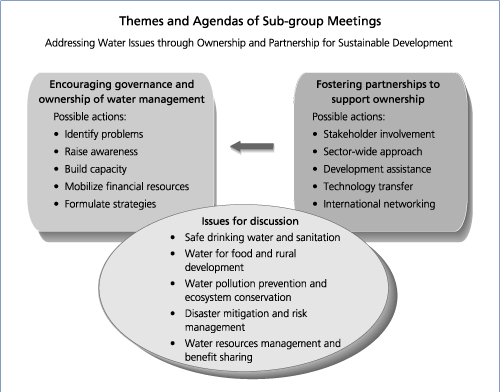
Efforts by Japan Japan recognizes the diversity of water-related problems and is providing assistance in many different sectors. It has provided water and sanitation facilities for 40 million people throughout the world. In order to ensure the stable operation of such facilities in the future, for example, experts were dispatched to Senegal to offer guidance in the establishment and operation of water management associations. These efforts will not only secure reliable access to safe drinking water, but are also expected to contribute to the improvement of educational opportunities and livelihoods by liberating women and children from the need to spend long hours carrying water. In the sanitation sector, Japan is contributing to the development of hygienic urban environments through the development of sewerage systems. For example, a yen loan has been provided to improve access to sanitation facilities and to protect the urban water environment in Ho Chi Minh City, where sewage treatment capacity has been unable to keep up with rapid population growth.
In addition, at the Johannesburg Summit, Japan and the United States jointly announced the Clean Water for People Initiative. Concrete measures of this joint initiative will be discussed toward the Third World Water Forum and the G8 Evian Summit. Although launched by Japan and the United States, the initiative will hopefully to expand as other countries and international organizations join in and also through closer collaboration with the efforts of other countries.
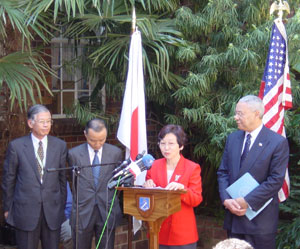
Foreign Minister Kawaguchi announces the Clean Water for People Initiative.

